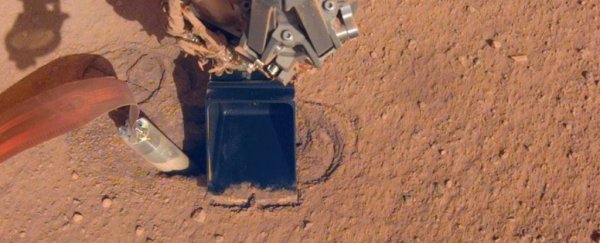NASA and the DLR are making some progress with the Mole. The Mole has been stuck for months now, and NASA/DLR have been working to get it unstuck. After removing the mole's housing to get a better look at it with InSight's cameras, the team came up with a plan.
The team is using the scoop on the end of the lander's instrument arm to exert sideways pressure on the Mole. That pressure is pushing the Mole against the side of its hole, supplying the friction the instrument needs to continue hammering its way below ground.
There aren't a lot of details on the progress right now. All NASA has given us is a tweet. In the gif, you can see the Mole working its way a little deeper.
With an assist from my robotic arm, the mole is digging again! We are just starting this new campaign, and are hopeful we can continue to dig.💪#Mars #Teamwork pic.twitter.com/Wkj7OhVG2y
— NASA InSight (@NASAInSight) October 15, 2019
The Mole is the short name for the Heat and Physical Properties Package (HP3) instrument. It's role is to hammer its way to a maximum depth of five meters (16 feet) and to measure the interior temperature of Mars.
It's a key part of InSight's overall mission to learn about the Martian interior and how it and other rocky planets formed.
But the Mole's mission has suffered setbacks. After being carefully deployed, the Mole began hammering into the surface only to strike a rock (Or so it's thought. There was no way of seeing in the hole.)
For a while, it looked like the Mole might work its way around the rock, but unfortunately it became stuck and made no further progress.
 (NASA/DLR)
(NASA/DLR)
The Mole was provided by the DLR, the German Aerospace Center. The DLR team operating the Mole ruled out a rock, and thought that the Mole might be stuck because of the nature of the Martian soil itself.
The Mole relies on friction between itself and the sides of the hole its creating to hammer itself further into the ground.
But the soil where it's operating is too crusty and isn't falling into the hole. NASA describes it as a kind of duricrust, a cemented soil that's different than other soil on Mars, and a type they didn't expect to encounter. The duricrust as about 5 to 10 centimeters (2 to 4 inches) thick, hidden by the loose surface material above it.
When they deployed the Mole, they had no way of knowing the duricrust would be there. Rather than flowing into the Mole's cavity and filling up space and providing the necessary friction, the duricrust is stubbornly refusing to help the Mole penetrate.
The first attempt to counter the duricrust was to push down on the soil around the hole with the scoop on the end of the instrument arm, to try to compact it against the Mole.
That, the InSight team thought, would restore the required friction. But that didn't work. The Mole was positioned near the furthest reach of the arm and the scoop, and the mechanics meant the scoop couldn't push down very hard.
I’ve pressed down next to the “mole” several times, and it’s hard to make this unusual soil collapse into the pit. Soon, I’ll be out of contact for a couple of weeks during solar conjunction, but my team on Earth will keep working it. Keep sending good vibes! ✨ pic.twitter.com/dbUcnXzYzm
— NASA InSight (@NASAInSight) August 16, 2019
Then they decided to try something else. With the HP3's support structure removed, they used the scoop to push directly on the Mole sideways, to force it into contact with the hole.
According to NASA's tweet, this might be working. But we can't be certain yet.
The Mole has a maximum operating depth of 5 meters (16 feet) but it can work at a shallower depth. At 2 meters (7 feet) it can do useful science, but at its current depth it can't measure anything.
Stay tuned for updates on the InSight lander's Mole.
This article was originally published by Universe Today. Read the original article.
